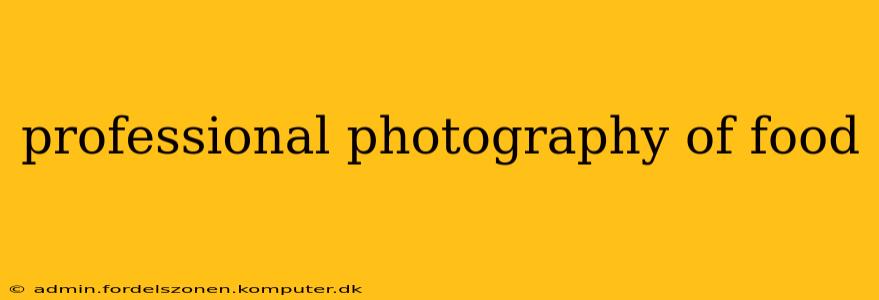Professional food photography is more than just snapping a picture of a plate of food. It's an art form that blends culinary expertise with photographic skill to create images that are both mouthwatering and visually stunning. This guide delves into the techniques, equipment, and considerations that elevate food photography from snapshots to professional-grade masterpieces. Whether you're a restaurant owner, food blogger, or simply passionate about capturing the beauty of food, this guide will provide you with the knowledge to capture truly captivating images.
What Makes Professional Food Photography Different?
Unlike casual food photos taken with a smartphone, professional food photography prioritizes several key elements:
-
Lighting: Professional photographers meticulously control lighting, using natural light or studio strobes to highlight textures, colors, and details. Flat lighting is avoided; instead, techniques like backlighting or side lighting create depth and visual interest.
-
Styling: The presentation of the food is paramount. Professional food stylists carefully arrange each element, ensuring visual appeal and appetizing aesthetics. This goes beyond simply plating; it often involves techniques like adding steam, strategically placing garnishes, and adjusting textures for maximum visual impact.
-
Composition: Understanding the rules of composition, such as the rule of thirds and leading lines, is critical. Professional photographers use these techniques to guide the viewer's eye and create a sense of balance and harmony within the image.
-
Post-Processing: While the goal is to capture the best image in-camera, post-processing plays a vital role. Professional photographers utilize editing software to enhance colors, adjust contrast, and subtly refine details, creating the final polished look.
What Equipment Do I Need for Professional Food Photography?
While you can achieve great results with a DSLR or mirrorless camera, certain equipment significantly enhances the quality of your food photos:
-
Camera: A high-resolution camera with manual settings is essential. DSLRs and mirrorless cameras offer the control needed for professional results.
-
Lenses: Macro lenses are ideal for capturing intricate details, while wide-angle lenses can capture the overall scene and setting.
-
Lighting: Continuous lighting (LED panels) or strobes offer controlled illumination, crucial for eliminating harsh shadows and achieving the desired mood. Reflectors are helpful for bouncing light and softening harshness.
-
Tripod: A tripod is indispensable for achieving sharp images, especially in low-light situations.
-
Props and Backgrounds: Choosing appropriate props and backgrounds is crucial to create a cohesive and visually appealing scene. Think about textures, colors, and overall style.
How Do I Style Food for Professional Photography?
Food styling is a skill in itself. Here are some key considerations:
-
Freshness: Use the freshest ingredients possible. Wilted or overly ripe produce will not photograph well.
-
Texture: Pay attention to the texture of the food. Highlight its qualities through careful styling and lighting.
-
Color: Consider the overall color palette. Complementary colors can create a visually appealing contrast.
-
Garnishes: Use garnishes strategically to add visual interest and enhance the presentation.
-
Props: Props can complement the food and tell a story. Use them thoughtfully.
What are the Best Settings for Food Photography?
The best settings depend on your lighting conditions and desired effect. However, some general guidelines include:
-
Aperture: A relatively shallow depth of field (wide aperture, e.g., f/2.8 or f/4) can create a pleasing blur in the background, highlighting the food.
-
Shutter Speed: A fast enough shutter speed to avoid motion blur is essential.
-
ISO: Keep the ISO as low as possible to minimize noise.
How Do I Edit My Food Photos Professionally?
Post-processing refines your images, bringing out their full potential. Popular software includes Adobe Lightroom and Photoshop. Focus on:
-
White Balance: Correcting white balance ensures accurate color representation.
-
Exposure: Adjusting exposure ensures optimal brightness and contrast.
-
Sharpness: Subtly sharpening the image enhances detail.
-
Color Grading: This allows you to subtly alter the overall color tone and mood.
What are Some Common Mistakes to Avoid in Food Photography?
Avoiding common mistakes is key to improving your skills:
-
Overly bright or harsh lighting: Soft, diffused lighting is generally preferred.
-
Poor composition: Understanding basic composition rules improves your shots significantly.
-
Cluttered backgrounds: Keep backgrounds simple and uncluttered.
-
Unrealistic styling: Avoid overly styled or artificial-looking food.
By mastering these techniques and understanding the nuances of professional food photography, you can create images that are not only visually appealing but also truly capture the essence and deliciousness of the food itself. Remember, practice is key! Experiment with different lighting, compositions, and styling techniques to find your unique style and voice.
